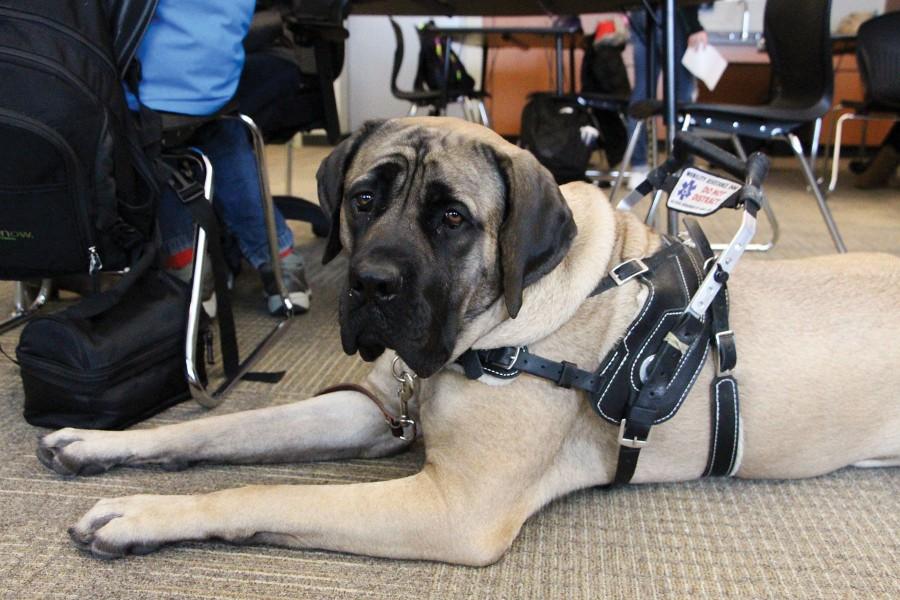Freshman Spencer Peck gets a new service dog
Students may have noticed an unfamiliar face roaming the halls of Southwest recently. However, this face doesn’t belong to a new student; it belongs to an English Mastiff, Whoopi. Whoopi is freshman Spencer Peck’s new service dog.
Whoopi is a mobility assistance dog. She helps Spencer move smoothly and stably throughout the halls of school, at home and anywhere else he may go.
When Spencer was two months old, he had an allergic reaction to a medication that led to him develop Neuromuscular Disorder, more commonly known as Cerebral Palsy. Cerebral Palsy is developed before, during or immediately after birth because of an injury to the infant’s growing brain. According to CerebralPalsy.org, the disorder is unique in each individual, but it has the ability to affect muscle control, muscle coordination, muscle tone, reflex, posture and balance.
The benefits of having a mobility assistance dog for Spencer are numerous, as Whoopi’s abilities help negate the effects of Cerebral Palsy that specifically affect Spencer. Spencer’s parents said it was important for him to have a Service dog to help bridge the gap between him and other children in addition to helping with his balance.
Not only does Whoopi help Spencer with mobility, but she also enables him to be more independent at school. Instead of Spencer constantly having a paraprofessional with him, he now has a four-legged companion. Whoopi provides him friendship, and she ensures he doesn’t fall as often.
“She is always by my side,” Spencer said. “I don’t think I need to fall that much, or that I need to fall at all, which I hate.”
Spencer only comes to school for two hours a day. He takes concert choir and an interpersonal skills class with special education teacher Brooke Claypool. Spencer’s class with Claypool is a social skills-based class where he and his peers work on social interaction and active engagement. Since Spencer works closely with other students in this hour, they were naturally inquisitive about Whoopi.
“We had a conversation as soon as [Whoopi] arrived that service dogs are [here] to work and they’re not supposed to be touched or interacted with, and that Spencer needs to give all the commands,” Claypool said. “For the most part, all of the students in my classroom have been really good about that. There is some definite curiosity because she is a big dog.”
However, curiosity hasn’t only been a problem in the classroom. Claypool said that on Spencer’s first day in the lunchroom with Whoopi, somebody reached out to pet her. Claypool and him then had to remind the student that Service Dogs are not meant to be pet.
“A lot of [service dogs] wear a vest, and she has the halter, but nothing that’s really apparent,” Claypool said. “It might not be as easy for somebody to stop and think, ‘Whoa, I shouldn’t be touching.’”
Spencer began his wait for a service dog at 8 years old. He was on the list of an agency that provides Service Dogs, the Kansas Specialty Dog Service (KSDS), for five years, but switched to a different organization after finding out that the KSDS does not grant service dogs to children under the age of 16. Then, Spencer’s family decided to put him on the waiting list of the Canine Assistance Rehabilitation Education and Services (CARES).
After waiting for 18 months, Spencer received his first service dog, Monroe, a Labrador retriever, on June 12, 2014. Monroe served as Spencer’s mobility assistance dog for nearly a year and a half, but after he contracted Rocky Mountain Spotted Fever on a camping trip, he was returned to CARES Nov. 6, 2015.
“After three months of medical care working to rehabilitate Monroe ourselves, it became clear Monroe would never return to work as a mobility service dog,” Spencer’s mother Bec Peck said. “Since Spencer’s primary need for a service dog is mobility and support, we realized Spencer needed a new dog.”
Spencer’s family then notified CARES that he would need a new service dog. CARES took a month to train a mobility assistance dog to exactly fit Spencer’s needs. On Dec. 9, 2015, Whoopi was placed in Spencer’s care. However, Spencer’s initial bonding and training with Whoopi was a bit different than it was with Monroe.
“During the first two weeks we had Whoopi in our home, Spencer was the only family member allowed to touch her or address her,” Bec said. “That was really hard on us, but really important for their bonding. Whoopi has to see Spencer as her alpha for her to bond with him, listen to him, follow his commands and want to work for him. This was really the most important part of their training. We didn’t do this as well with Monroe. The result was that Monroe didn’t listen to Spencer as well as the rest of the family.”
Whoopi is a much larger dog than Monroe. Monroe was around 75 pounds, whereas Whoopi weighs in at over 140 pounds. Whoopi’s size categorizes her as an extra-large dog. This also means that she has a higher center of gravity than Monroe, which helps Spencer maintain his balance.
Not only does Whoopi help maintain Spencer’s balance, but she also helps boost his self-esteem. She is there for Spencer and comforts him when he deals with normal teenage issues. She licks his face and helps him walk a little taller.
“They look at the dog,” Bec said. “It moves the attention to, ‘Why does that kid get a dog in the grocery store?’ rather than, ‘Why does that kid have crutches?’”
Whoopi doesn’t only instill a sense of comfort and independence in Spencer, but she instills this in his parents as well. His parents now see him becoming more independent and don’t have to worry as much about Spencer having low self-esteem because of people looking at him for his disabilities.
“He doesn’t want to be seen as a kid with disabilities,” Bec said. “He wants to be seen as a kid. What is more typical than a boy with a dog?”

This is Donna Armstrong's third year on The Standard. She is currently the Online Editor. Besides being involved in newspaper, Donna is a member of National...










